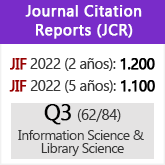Evolución y tendencias en investigación sobre paradiplomacia. Un análisis bibliométrico
DOI:
https://doi.org/10.3989/redc.2023.1.1960Palabras clave:
paradiplomacia, análisis bibliométrico, actores subnacionales, relaciones InternacionalesResumen
Este artículo de investigación ofrece un análisis bibliométrico de la paradiplomacia. El análisis aborda tres dimensiones. La primera caracteriza el contexto de las publicaciones científicas sobre el tema: número de publicaciones, tipos de documentos publicados, idioma y países de origen de los documentos. La segunda es el impacto de estas publicaciones: autores representativos, concentración de citas por autores y revistas relevantes. La tercera, de contenido, identifica temas recurrentes y emergentes en la investigación de la paradiplomacia. Utiliza una metodología cuantitativa con mecanismos estadísticos y de recolección de información en Scopus desde 1984 hasta 2021. Se concluye, entre otras cuestiones, que, si bien la paradiplomacia se encuentra en un momento de desarrollo y consolidación investigativa, se debe trabajar en la consolidación de medios especializados para difundir artículos y establecer redes entre investigadores de la paradiplomacia.
Descargas
Citas
Cornago, N. (2000). Exploring the global dimensions of paradiplomacy functional and normative dynamics in the global spreading of subnational involvement in international affairs. Ottawa: Forum of Federations.
Duchacek, D. (1984). The International Dimension of Subnational Self-Government. Oxford Journals, 5-31. https://doi.org/10.2307/3330188
Duchacek, I. D. (1984). The International Dimension of Subnational Self-Government. Publius: The Journal of Federalism, 14(4), 5-31. https://doi.org/10.2307/3330188
Duchacek, I. D. (1986a). Territorial Dimension of Politics: Within, Among and Across Nations. Boulder: Westview Press.
Duchacek, I. D. (1986b). International Competence of Subnational Governments: Borderlines and Beyond. In O. J. Martínez, Across Boundaries: Transborder Interaction in Comparative Perspective. El Paso: Texas Western Press.
Duchacek, I. D. (1988). Multicommunal and Bicommunal Polities and their International Relations. In I. D. Duchacek, D. Latouche, & G. Stevenson, Perforated Sovereignties and International Relations: Trans-Sovereign Contacts of Subnational Governments. New York & London: Greenwood Press.
Duchacek, I. D. (1990). Perforated Sovereignties: Towards a Typology of New Actors in International Relations. In H. J. Michelmann, & P. Soldatos, Federalism and International Relations. The role of subnational units,1-33. New York: Oxford University Press.
Ellegaard, O., & Wallin, J. (2015). The bibliometric analysis of scholarly production: How great is the impact? Scientometrics, 1809-1831. https://doi.org/10.1007/s11192-015-1645-z PMid:26594073 PMCid:PMC4643120
Keating, M. (1999). Regions and International Affairs: Motives, Opportunities and Strategies. In F. Aldecoa, & M. Keating, Paradiplomacy in action: the foreign relations of subnational governments,1-16. London; Portland: Frank Cass Publishers. https://doi.org/10.1080/13597569908421068
Kincaid, J. (2003). Foreign Relations of Sub-national Units. Constituent Diplomacy in Federal Systems. In R. Blindenbacher, & A. Koller, Federalism in a Changing World: Learning from Each Other, 74-96. St. Gallen: McGill-Queen's Press.
Mesa Bedoya, J. C. (2020). Paradiplomacia y Desarrollo Endógeno: Estudio de caso de la ciudad de Medellín. 2000-2015. Relaciones Internacionales, 29(59), 225-269. https://doi.org/10.24215/23142766e115
Mesa Bedoya, J. C. (2020a). Paradiplomacia y Desarrollo Endógeno. Estudio de caso de la ciudad de Medellín. 2000-2015. Tesis Doctoral. Universidad Nacional de La Plata. Available at: http://sedici.unlp.edu.ar/handle/10915/115212
Mesa Bedoya, J. C. (2021). El rol de las políticas públicas y de la ACI en la internacionalización de Medellín. In D. Bonilla, Entorno global de las organizaciones: Estrategias para la internacionalización empresarial, 361-404. Sabaneta: Fondo Editorial CEIPA.
Ramírez, A. (2009). La teoría del conocimiento en investigación científica: una visión actual. Anales de la Facultad de Medicina, 217-224.
Restrepo, C., & Urbizagástegui, R. (2017). Red de co-palabras en la bibliometría mexicana. Investigación Bibliotecológica, 17-45. https://doi.org/10.22201/iibi.24488321xe.2017.73.57845
Smith, N. (1988). Paradiplomacy between the U.S. and Canadian provinces: The case of acid rain memoranda of understanding. Journal of Borderlands Studies, 13-38. https://doi.org/10.1080/08865655.1988.9695350
Soldatos, P. (1990). An Explanatory Framework for the Study of Federated States as Foreign-policy Actors. In H. J. Michelman, & P. Soldatos, Federalism and International Relations. The role of Subnational Units, 34-53. New York: Oxford University Press.
Soldatos, P. (1993). Cascading Subnational Paradiplomacy in an Interdepentent and Transnational World. In D. M. Brown, & E. H. Fry, States and Provinces in the international economy, 45-64. Berkeley: Institute of Governamental Studies Press University of California & Institute of Intergovernamental Relations Queen's University.
Soldatos, P., & Michelmann, H. (1992). Subnational units* paradiplomacy in the context of european integration. Journal of European Integration, 129-134. https://doi.org/10.1080/07036339208428971
Vos, H., Boucké, T., & Devos, C. (2002). The Conditio Sine Qua Non of the Added Value of Regions in the EU: Upper-level Representation as the Fundamental Precondition. Journal of European Integration, 201-2018. https://doi.org/10.1080/07036330220152187
Zeraoui, Z. (2011). Diplomacia paralela y las relaciones internacionales de las regiones. Desafíos, 23(1), 59-96.
Zerauoi, Z. (2016). Para entender la paradiplomacia. Desafíos, 15-34. https://doi.org/10.12804/revistas.urosario.edu.co/desafios/a.4470
Publicado
Cómo citar
Número
Sección
Licencia
Derechos de autor 2023 Consejo Superior de Investigaciones Científicas (CSIC)

Esta obra está bajo una licencia internacional Creative Commons Atribución 4.0.
© CSIC. Los originales publicados en las ediciones impresa y electrónica de esta Revista son propiedad del Consejo Superior de Investigaciones Científicas, siendo necesario citar la procedencia en cualquier reproducción parcial o total.Salvo indicación contraria, todos los contenidos de la edición electrónica se distribuyen bajo una licencia de uso y distribución “Creative Commons Reconocimiento 4.0 Internacional ” (CC BY 4.0). Puede consultar desde aquí la versión informativa y el texto legal de la licencia. Esta circunstancia ha de hacerse constar expresamente de esta forma cuando sea necesario.
No se autoriza el depósito en repositorios, páginas web personales o similares de cualquier otra versión distinta a la publicada por el editor.

















